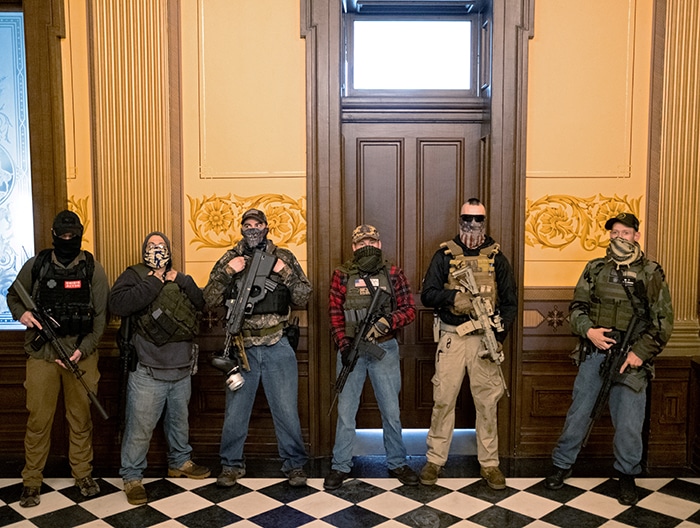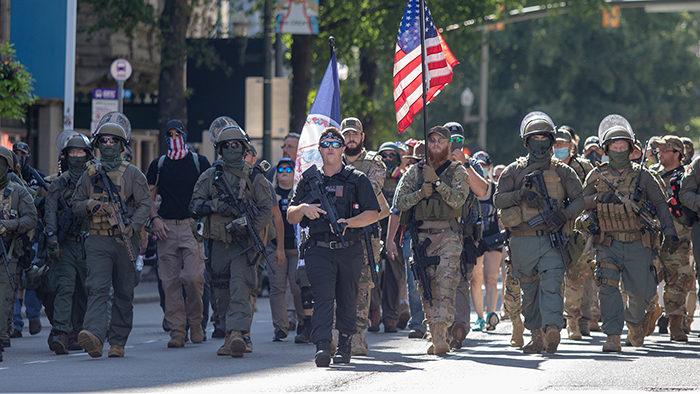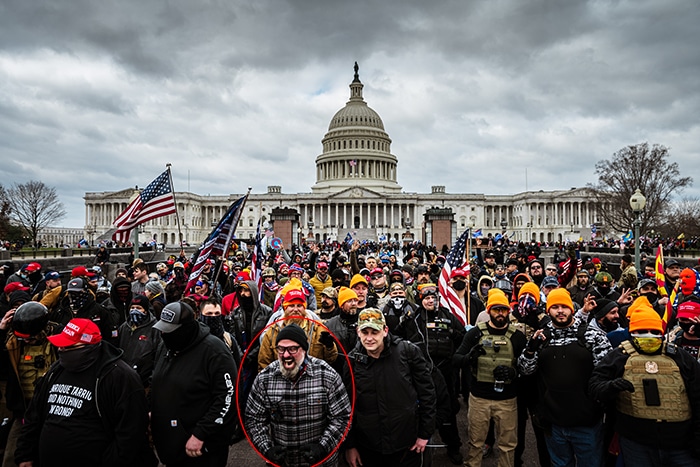Extremism Among Active-Duty Military and Veterans Remains a Clear and Present Danger
An Oct. 13 congressional hearing by the Committee on Veterans’ Affairs on “Violent Domestic Extremist Groups and the Recruitment of Veterans” will highlight the dangers of extremism in the military, an issue SPLC, academics and activists have been warning about for decades.
SPLC submitted a statement for the record as part of these hearings, highlighting both the nature of the threat and policy recommendations for Congress, the Biden administration, and the Department of Veterans’ Affairs.
Kyle Bibby, a Marine veteran and national campaigns manager for Common Defense, a progressive, grassroots veterans organization, told Hatewatch there is need for action.
Extremism in the military is “definitely present,” Bibby states. “I’ve had conversations with enlisted guys about it, particularly since I’ve gotten out.”
Sometimes, the problem can be severe, putting service members in an unsafe environment. Bibby shared the story of a Common Defense member who is Jewish and had active neo-Nazis in his unit.
“I don’t think the military takes it seriously, but again they are a reflection of our greater society not taking it seriously. Hopefully Jan. 6 would have made that more clear,” Bibby said.
Military experience has strategic and social value for extremists
Extremist groups have also blatantly attempted to recruit active-duty military and veterans. These groups have used flyering, online platforms and rallies in their efforts.
“There’s an active effort to recruit in the military,” Bibby said.
He explained: “There are two things that happen: Either people are already involved in these groups and then they join the military with the forethought and purpose of being trained militarily so that way they can fight the great white war in the future … Or they’re young, they’re impressionable, haven’t really gone anywhere and they just end up coming across the ‘right person’ who tells them what they want to hear and uses their vulnerabilities to make them believe in this lie of supremacy.”
Experts echoed and expanded on Bibby’s analysis.
Dr. Pete Simi, a sociology professor at Chapman University who researches right-wing extremism, told Hatewatch there are various causes as to why current and former members of the military join extremist groups and why they are targeted.
Simi pointed to two reasons that extremist groups recruit individuals with military backgrounds. One is the cachet that comes from having members with military experience in the group. “It’s kind of a reputation builder,” Simi said, “a way to enhance your collective identity.”
The other is the “strategic aspect,” Simi said. Extremist groups need people with leadership training, general weapons and explosives skills.
Mirroring military structure and norms
Many right-wing extremist groups mimic the structures and cultural norms found in the military.
Militias in particular mirror their membership structure around military ranks, giving members titles typically reserved for legitimate military personnel. Militias and white supremacist groups also commonly engage in paramilitary training, including field training exercises. The U.S. Army describes this as part of basic training where soldiers “begin learning the tactical skills they will need to be successful on the battlefield.”
Culturally, the two environments also share a tendency toward hypermasculinity. Military and far-right extremist groups both tend to be male-dominated spaces with rigid gender roles that venerate traditional masculinity, according to Simi.
“It’s that familiarity that people are often so comfortable with and are looking for,” Simi said. This can make militias attractive to military members.
Daryl Johnson, the former lead analyst for domestic terrorism at the U.S. Department of Homeland Security, described for Hatewatch the phenomenon of paramilitary structures giving former service members a place to belong: “Just comrades in arms – belonging to a group where people are out doing field training exercises. Paramilitary training activity gives them that sense of camaraderie.”
Members with military experience are also uniquely suited to leadership positions, Johnson explained, and can help these groups run more efficiently.
“All these things,” said Johnson, “boost the violent capabilities of extremists, and also can increase their lethality as well as make them much more sophisticated than what they normally would be.”
Extremists can also exploit and distort military members’ and veterans’ sense of patriotism. Johnson told Hatewatch there is a “notion among right-wing extremists, particularly the militias, that they’re doing this for a patriotic cause or extreme forms of nationalism. That marries up very well with people who volunteer for the military.”
The nationwide antigovernment Oath Keepers militia is an example of this. Led by U.S. Army veteran Stewart Rhodes, the organization energetically targets active-duty soldiers and veterans, along with law enforcement, by appealing specifically to their patriotism and the oath they took to protect the country.
Lack of resources and support can make returning soldiers vulnerable
Johnson co-authored a 2009 DHS report on right-wing extremism that issued a dire warning: “The return of military veterans facing significant challenges reintegrating into their communities could lead to the potential emergence of terrorist groups or lone wolf extremists capable of carrying out violent attacks.”
Service abroad can also contribute to bigoted beliefs and practices, Johnson said, especially in a theater where the tactical enemy is made up primarily of one particular ethnic group. Soldiers attracted to white supremacy groups often do so based on a hatred of minorities, including Muslims. “We know that a lot of white supremacists have been involved in Islamophobia and targeting mosques and mistaking Sikhs for Muslims,” he said.
Johnson also pointed to the adrenaline rush soldiers often experience on the battlefield and during military training exercises, explaining that this rush is often missing when they come back, until militias provide them with the opportunity to get it back.
The battlefield can also cause post-traumatic stress disorder (PTSD) – which, along with isolation, discharge from the military and exposure to online extremist content, could leave veterans vulnerable to radicalization.
There is no formal, definitive connection between terrorism and mental illness. Links between extremism and PTSD have not been medically or academically confirmed, only PTSD and violence, more generally. The U.S. Department of Veterans Affairs (VA) cites multiple studies investigating the link between combat-related PTSD and violence, which found that the prevalence of violence among post-9/11 veterans with PTSD is between 8.6%-19.5%, while the prevalence among U.S. adults without any mental health disorders or military service is much lower, between 2%-3%.
Extremists have recounted their own experience with post-service PTSD. Proud Boys organizer, former Infowars staff member and Capitol insurrectionist Joe Biggs shared his experience with PTSD on the online show “Veteran Cast” on Nov. 21, 2018.
Biggs said his symptoms started after he returned from deployment and was forced to leave his unit, which he considered family, and relocate to El Paso, Texas. He said he felt isolated after the move and would think of combat when left alone. Biggs said he began drinking heavily and tried to commit suicide.
Feelings of isolation and lack of belonging can be a driver of radicalization, according to the PERIL Guide to Online Radicalization for Parents and Caretakers produced by SPLC and American University. Former extremists have expressed that joining extremist groups eased those feelings of isolation and created a sense of family.
Nathan Damigo, former leader of white nationalist group Identity Europa, now called the American Identity Movement, also suffered from PTSD. His condition was documented by HBO for a show on the subject. Damigo joined the Marines at 18 and was deployed to Iraq. He said he attempted suicide after his first of two tours.
Like Biggs, Damigo has said he abused alcohol. During that time, Damigo attacked and robbed an Arab cab driver. Damigo spent a year in county jail and four years in prison, and he received an Other Than Honorable discharge from the military, an experience he said left him feeling betrayed.
According to a 2013 academic study that Simi and others conducted, an Other Than Honorable discharge “disrupts the person’s military identity and creates an uncertain future” and is viewed as a “personal failure.” That sense of failure is then “reconstituted as anger toward an ‘unjust system,’” the study says.
Just like civilians, service members are increasingly radicalized on the internet
Military members and veterans are among the many radicalized online.
A July 2018 research brief by the National Consortium for the Study of Terrorism found that between 2005 and 2016, social media usage by extremists grew exponentially, and 52.22% of extremists who were involved in violent domestic extremist activities actively used social media.
Neo-Nazi group Atomwaffen Division (AWD) used YouTube and the fascist web forum Iron March to recruit and spread their beliefs. The group claimed multiple members with U.S. military experience, including leader Brandon Russell, who was in the 53rd Brigade Special Troops Battalion of the Florida National Guard.
Russell’s fellow AWD member and Tampa, Florida, roommate Devon Arthurs has been charged with shooting and killing their roommates, Andrew Oneschuk and Jeremy Himmelman, who led AWD’s Massachusetts chapter.
Three days after the murders, on May 20, AWD posted a recruitment video to YouTube urging viewers to “Join Your local nazis.” The video garnered 2,300 views.
The AWD YouTube channel remained active until March 2018, when YouTube said it was removed “due to multiple or severe violations of YouTube’s policy prohibiting hate speech.” The move came after months of public pressure.
‘Just cap her’: Military presence in the boogaloo movement
Tech companies have often been slow to respond to the extremist content on their social media sites. Facebook’s strategy has been slow and seen mixed results, and Twitter has refused to take down accounts of known far-right extremists.
The boogaloo movement, an amalgam of gun rights advocates, antigovernment individuals and white nationalists who advocate for civil war in America, has attracted some service members online.
Steven Carrillo, former team leader for the Air Force’s elite security unit Phoenix Raven, said he was introduced to the boogaloo movement “through friends in the Air Force and on the internet."
Carrillo is currently charged with murder and attempted murder after a shootout with California sheriffs.
He is one of multiple members of the boogaloo movement with military backgrounds to be arrested and charged in the past year for charges including murder, conspiracies against the United States or providing material support for terrorism, amongst others.

On Oct. 7, 2020, a man who went by the online moniker “Boogaloo Bunyan” was arrested along with 12 other men and faces multiple charges associated with a plot to kidnap Michigan Gov. Gretchen Whitmer. On April 28, five of the men were handed additional charges in an indictment that labeled their actions as domestic terrorism.
Boogaloo Bunyan’s legal name is Joseph Morrison. He was a member of the U.S. Marines from 2015 until his discharge on Oct. 8, 2020, and was assigned to an Engineer Support Company in Battle Creek, Michigan. Morrison was also the leader of the Wolverine Watchmen, the main militia involved in the plot against the governor.
Daniel Joseph Harris, a U.S. Marine from June 2015 to June 2019 who attained the rank of corporal E-4, was a member of Morrison’s militia. In an Aug. 9, 2020, group chat with fellow conspirators, Harris wrote that one person should “go to [Whitmer’s] house. Knock on the door and when she answers it, just cap her.”
Morrison faces charges of gang membership, felony firearm possession and providing material support for terrorism. Harris is charged with kidnapping conspiracy and knowingly conspiring to use weapons of mass destruction against persons or property.
Though the threat of extremism among current and former servicemembers has been present for years, the Jan. 6 insurrection has prompted new scrutiny by the government.
On his first full day in office, President Joe Biden ordered a comprehensive 100-day review of the government’s efforts addressing domestic terrorism, which the White House called “the most urgent terrorism threat the United States faces today.”
Upon completion of the review, the White House unveiled strategies including the implementation of Department of Defense (DOD) trainings for service members transitioning out of the military who may be susceptible to radicalization.
Bibby, of Common Defense, hopes the military takes this issue seriously. “The military needs to view this as a national security threat, not just kind of a recruiting issue,” he said. “I do think that most of the command in the military, if they encounter white nationalist involvement ... they would want to deal with it.”
Secretary of Defense Lloyd J. Austin III said during a Feb. 19 speech on extremism that it concerns him “to think that anyone wearing the uniform of a soldier, or a sailor, an airman, Marine, or Guardian or Coast Guardsman would espouse these sorts of beliefs, let alone act on them. But they do. Some of them still do.”
Some in military leadership still deny there is an issue. Two military commanders, Adm. Charles Richard of U.S. Strategic Command and Gen. James Dickinson of Space Command, told Congress on April 16 they had no extremists under their command, which includes over 150,000 service people.
But Secretary Austin announced on April 21 that the military would form a “countering extremism working group” as part of a larger 60-day Leadership Stand-Down to Address Extremism in the Force.
Austin implemented the program across the entire Defense Department. Unit commanders and supervisors were ordered to hold conversations on the subject with their formations between February and early April.
To facilitate the stand-down, a guide was produced by the Department of Defense, with talking points, prohibited activities, resources and references. One prohibition, listed under the category “Dignity and Respect,” states, “DoD policy expressly prohibits Service members from actively advocating supremacist, extremist, or criminal gang doctrine, ideology and causes.”
A Duty to Reject section says there will be a “full range of administrative and disciplinary actions, including involuntary separation, dismissal, or even appropriate criminal prosecution against those who actively engage in such activity.”
The Oct. 13 hearing, which will include the testimony of a cadre of experts, is another opportunity for the government to take a deeper look at the issue, which can result in new and more substantive changes.
Johnson lauds the Biden administration for having the first ever federal government strategy on domestic extremism. But he explained there will be challenges to long-term success.
“So, we have some positive things developing,” Johnson said, “but unfortunately it is going to take months and years for these things to come to fruition and mature and this threat has had over a decade to grow … so we’re behind.”
Johnson recommends better training for military adjudicators and investigators on how to spot extremist beliefs, tightened vetting of individuals who get security clearances, including military officers and civilians, and better social media monitoring.
Suggestions by SPLC’s Action Fund include the establishment of anti-racist programming, courses and training against white supremacy and extremism at U.S. service academies, and an updated military promotion review process that includes an evaluation of any affiliations or expressions of extremism, racism and discrimination by the candidate.
Bibby said creating an anti-extremist culture is well within the military’s ability.
“We indoctrinate and give people culture everyday. … That’s literally what the Marine Corps [and other branches] do,” he said. “There is a way for you to do that in such a way that is also cognizant of the real history of this country and enforcing things in a way in which we enforce other things that we deem as a problem.”
The veterans organization spokesman claimed widespread change to confront this threat was necessary. “If ISIS was trying to infiltrate the military by joining,” Bibby asked, “how would we react?”



